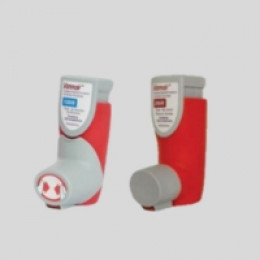Vannair
Key points about Vannair
- Vannair® is a combination of 2 medicines, budesonide and formoterol, in a single inhaler.
- The combination is used to treat the symptoms of asthma and COPD and to prevent them from recurring.
- Find out how to take it safely and possible side effects.


Vannair® is a combination of 2 medicines, budesonide and formoterol, in a single inhaler. The combination is used to treat the symptoms of asthma and COPD and to prevent them from recurring.
- Budesonide is a corticosteroid. When inhaled prevents swelling and irritation in the walls of the small air passages in your lungs. It is also called a preventer because when used every day it prevents asthma attacks.
- Formoterol is a long-acting, fast onset bronchodilator. It relaxes and opens up your air passages, making breathing easier.
In Aotearoa New Zealand, Vannair is available as a metered dose inhaler (MDI) in different strengths: Vannair 100/6 and Vannair 200/6.
Using Vannair for COPD
Use Vannair twice a day every day as a preventer, to prevent shortness of breath and wheezing. Read more about medicines for COPD.
Using Vannair for asthma
Use Vannair as regular preventer for moderate to severe asthma, every day, once or twice daily. You'll use another inhaler for relief of symptoms such as salbutamol. Read more about asthma first aid.
- Always use your inhaler exactly as your doctor has told you: The pharmacy label on your medicine tells you how much to take, how often to take it and any special instructions.
- Vannair inhalers are available in different strengths: Ask your doctor or pharmacist which strength you are taking. If your inhaler looks different to what you were expecting, ask your pharmacist about this.
- Rinse your mouth after each use: Vannair can cause a sore throat and hoarse voice. Rinse your mouth after each use to prevent this.
- Expiry: Some inhalers have a shorter expiry date when they are removed from their packaging. It's a good idea to write the date the inhaler is removed from it's packaging on the label of the inhaler. Check the manufacturer's advice on when the inhaler should be discarded as this varies depending on the device and medicine.
Use your MDI with a spacer
- A spacer is an attachment to use with your inhaler. It's a chamber that holds the medication before you inhale, giving you a more controlled, deeper inhalation. This can be especially helpful if you are short of breath.
- Using your MDI with a spacer makes it easier to use the inhaler and helps to get the medicine into your lungs, where it’s needed (with less medicine ending up in your mouth and throat).
Check your technique
- To get the most benefit from your inhaler, it's important to use the correct technique.
- Ask your healthcare provider to show you how to use your MDI and spacer devices.
- Even if you’ve been shown before, ask your healthcare provider to explain how to use your inhaler if you still have any questions.
The videos below provide some guidance on how to use a spacer with your MDI. Note: Your MDI or spacer may look different to the one in the videos below.
Video: How to use your spacer device
(Healthify He Puna Waiora, NZ and Auckland District Health Board, 2018)
Video: MDI and spacer
(Asthma Waikato, NZ, 2018)
Like all medicines Vannair can cause side effects, although not everyone gets them. Often side effects improve as your body adjusts to the new medicine.
| Side effects | What should I do? |
|---|---|
|
|
|
|
|
|
|
|
Read more about medicines and side effects and reporting a reaction you think might be a side effect.
Budesonide and formoterol(external link) NZ Formulary Patient Information
Vannair(external link) Medsafe Consumer Information Sheets, NZ
Brochures
5 questions to ask about your medications(external link) Health Quality and Safety Commission, NZ, 2019 English(external link), te reo Māori(external link)
Medicines and side effects [PDF, 91 KB] Healthify He Puna Waiora, NZ, 2024
In use shelf life of inhalers(external link) National Asthma Council, Australia, 2024
References
- Budesonide + formoterol(external link) NZ Formulary
Brochures

Medicines and side effects
Healthify He Puna Waiora, NZ, 2024

Health Quality and Safety Commission, NZ, 2019 English, te reo Māori
Credits: Sandra Ponen, Pharmacist, Healthify He Puna Waiora. Healthify is brought to you by Health Navigator Charitable Trust.
Reviewed by: Angela Lambie, Pharmacist, Auckland
Last reviewed:
Page last updated:





